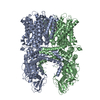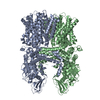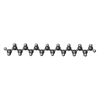[English] 日本語
 Yorodumi
Yorodumi- PDB-7y3e: Cryo-EM structure of Arabidopsis thaliana SOS1 in an occluded state -
+ Open data
Open data
- Basic information
Basic information
| Entry | Database: PDB / ID: 7y3e | ||||||
|---|---|---|---|---|---|---|---|
| Title | Cryo-EM structure of Arabidopsis thaliana SOS1 in an occluded state | ||||||
 Components Components | Sodium/hydrogen exchanger 7 | ||||||
 Keywords Keywords |  MEMBRANE PROTEIN / Sodium/proton antiporter MEMBRANE PROTEIN / Sodium/proton antiporter | ||||||
| Function / homology |  Function and homology information Function and homology informationsodium:proton antiporter activity /  chloroplast envelope / regulation of reactive oxygen species metabolic process / sodium ion transport / potassium ion transmembrane transport / response to salt stress / response to reactive oxygen species / response to hydrogen peroxide / response to oxidative stress / chloroplast envelope / regulation of reactive oxygen species metabolic process / sodium ion transport / potassium ion transmembrane transport / response to salt stress / response to reactive oxygen species / response to hydrogen peroxide / response to oxidative stress /  plasma membrane plasma membraneSimilarity search - Function | ||||||
| Biological species |   Arabidopsis thaliana (thale cress) Arabidopsis thaliana (thale cress) | ||||||
| Method |  ELECTRON MICROSCOPY / ELECTRON MICROSCOPY /  single particle reconstruction / single particle reconstruction /  cryo EM / Resolution: 2.8 Å cryo EM / Resolution: 2.8 Å | ||||||
 Authors Authors | Wang, Y. / Zhao, Y. / Gao, Y. | ||||||
| Funding support |  China, 1items China, 1items
| ||||||
 Citation Citation |  Journal: Nat Commun / Year: 2023 Journal: Nat Commun / Year: 2023Title: Architecture and autoinhibitory mechanism of the plasma membrane Na/H antiporter SOS1 in Arabidopsis. Authors: Yuhang Wang / Chengcai Pan / Qihao Chen / Qing Xie / Yiwei Gao / Lingli He / Yue Li / Yanli Dong / Xingyu Jiang / Yan Zhao /  Abstract: Salt-overly-sensitive 1 (SOS1) is a unique electroneutral Na/H antiporter at the plasma membrane of higher plants and plays a central role in resisting salt stress. SOS1 is kept in a resting state ...Salt-overly-sensitive 1 (SOS1) is a unique electroneutral Na/H antiporter at the plasma membrane of higher plants and plays a central role in resisting salt stress. SOS1 is kept in a resting state with basal activity and activated upon phosphorylation. Here, we report the structures of SOS1. SOS1 forms a homodimer, with each monomer composed of transmembrane and intracellular domains. We find that SOS1 is locked in an occluded state by shifting of the lateral-gate TM5b toward the dimerization domain, thus shielding the Na/H binding site. We speculate that the dimerization of the intracellular domain is crucial to stabilize the transporter in this specific conformation. Moreover, two discrete fragments and a residue W1013 are important to prevent the transition of SOS1 to an alternative conformational state, as validated by functional complementation assays. Our study enriches understanding of the alternate access model of eukaryotic Na/H exchangers. | ||||||
| History |
|
- Structure visualization
Structure visualization
| Structure viewer | Molecule:  Molmil Molmil Jmol/JSmol Jmol/JSmol |
|---|
- Downloads & links
Downloads & links
- Download
Download
| PDBx/mmCIF format |  7y3e.cif.gz 7y3e.cif.gz | 329.1 KB | Display |  PDBx/mmCIF format PDBx/mmCIF format |
|---|---|---|---|---|
| PDB format |  pdb7y3e.ent.gz pdb7y3e.ent.gz | 262.7 KB | Display |  PDB format PDB format |
| PDBx/mmJSON format |  7y3e.json.gz 7y3e.json.gz | Tree view |  PDBx/mmJSON format PDBx/mmJSON format | |
| Others |  Other downloads Other downloads |
-Validation report
| Arichive directory |  https://data.pdbj.org/pub/pdb/validation_reports/y3/7y3e https://data.pdbj.org/pub/pdb/validation_reports/y3/7y3e ftp://data.pdbj.org/pub/pdb/validation_reports/y3/7y3e ftp://data.pdbj.org/pub/pdb/validation_reports/y3/7y3e | HTTPS FTP |
|---|
-Related structure data
| Related structure data |  33592MC  8hyaC M: map data used to model this data C: citing same article ( |
|---|---|
| Similar structure data | Similarity search - Function & homology  F&H Search F&H Search |
- Links
Links
- Assembly
Assembly
| Deposited unit | 
|
|---|---|
| 1 |
|
- Components
Components
| #1: Protein | Mass: 127327.891 Da / Num. of mol.: 2 Source method: isolated from a genetically manipulated source Source: (gene. exp.)   Arabidopsis thaliana (thale cress) / Gene: SOS1 / Cell line (production host): HEK293 / Production host: Arabidopsis thaliana (thale cress) / Gene: SOS1 / Cell line (production host): HEK293 / Production host:   Homo sapiens (human) / References: UniProt: Q9LKW9 Homo sapiens (human) / References: UniProt: Q9LKW9#2: Chemical | ChemComp-R16 /  Hexadecane HexadecaneHas ligand of interest | Y | |
|---|
-Experimental details
-Experiment
| Experiment | Method:  ELECTRON MICROSCOPY ELECTRON MICROSCOPY |
|---|---|
| EM experiment | Aggregation state: PARTICLE / 3D reconstruction method:  single particle reconstruction single particle reconstruction |
- Sample preparation
Sample preparation
| Component | Name: Arabidopsis sodium/hydrogen exchanger 7 (SOS1), homodimer Type: COMPLEX / Entity ID: #1 / Source: RECOMBINANT |
|---|---|
| Source (natural) | Organism:   Arabidopsis thaliana (thale cress) Arabidopsis thaliana (thale cress) |
| Source (recombinant) | Organism:   Homo sapiens (human) / Cell: HEK293 Homo sapiens (human) / Cell: HEK293 |
| Buffer solution | pH: 7.5 |
| Specimen | Embedding applied: NO / Shadowing applied: NO / Staining applied : NO / Vitrification applied : NO / Vitrification applied : YES : YES |
Vitrification | Cryogen name: ETHANE |
- Electron microscopy imaging
Electron microscopy imaging
| Experimental equipment |  Model: Titan Krios / Image courtesy: FEI Company |
|---|---|
| Microscopy | Model: FEI TITAN KRIOS |
| Electron gun | Electron source : :  FIELD EMISSION GUN / Accelerating voltage: 300 kV / Illumination mode: FLOOD BEAM FIELD EMISSION GUN / Accelerating voltage: 300 kV / Illumination mode: FLOOD BEAM |
| Electron lens | Mode: BRIGHT FIELD Bright-field microscopy / Nominal defocus max: 22000 nm / Nominal defocus min: 12000 nm Bright-field microscopy / Nominal defocus max: 22000 nm / Nominal defocus min: 12000 nm |
| Image recording | Electron dose: 60 e/Å2 / Film or detector model: GATAN K2 SUMMIT (4k x 4k) |
- Processing
Processing
| Software | Name: PHENIX / Version: 1.18.2_3874: / Classification: refinement | ||||||||||||||||||||||||
|---|---|---|---|---|---|---|---|---|---|---|---|---|---|---|---|---|---|---|---|---|---|---|---|---|---|
CTF correction | Type: PHASE FLIPPING ONLY | ||||||||||||||||||||||||
3D reconstruction | Resolution: 2.8 Å / Resolution method: FSC 0.143 CUT-OFF / Num. of particles: 146538 / Symmetry type: POINT | ||||||||||||||||||||||||
| Refine LS restraints |
|
 Movie
Movie Controller
Controller



 PDBj
PDBj




